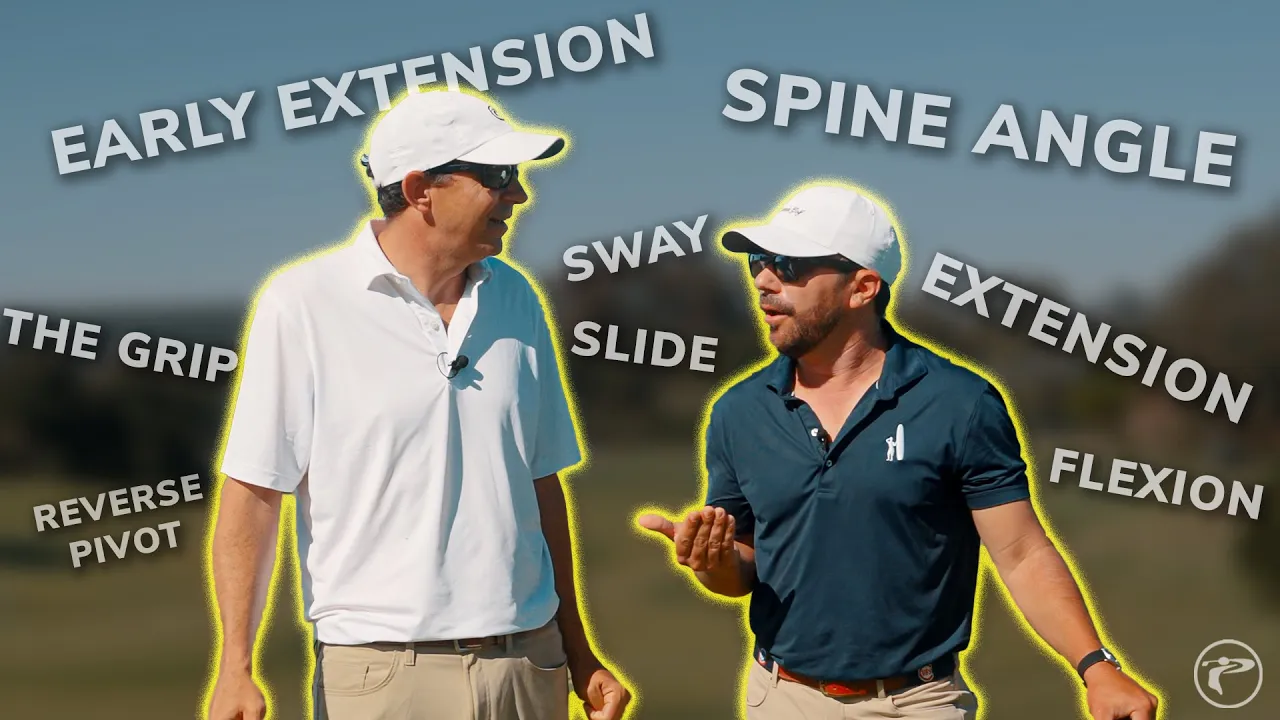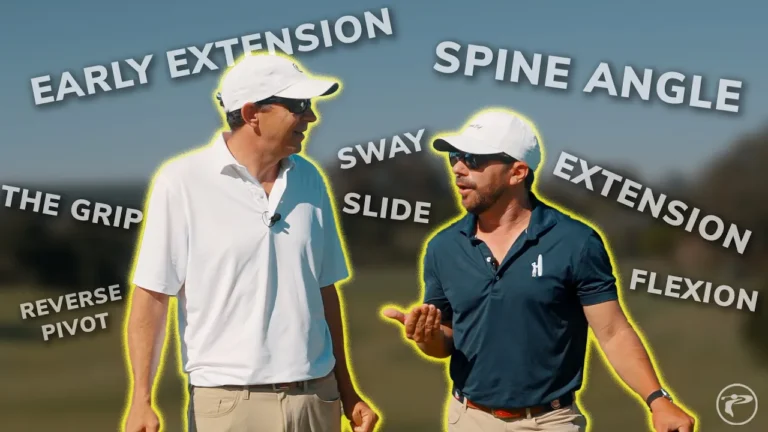
Unlock the secrets of golf with our comprehensive guide to essential golfing terminology. Enhance your skills and communicate like a pro on the course.
Table of Contents
- Intro to Golf Terminology
- Grip Fundamentals: Weak vs. Strong
- Flexion and Extension in Golf
- The Release: Timing and Technique
- Swing Plane and Hand Path
- Join the Masterclass
Intro to Golf Terminology
Golf is filled with unique terms that define various aspects of the game. Understanding this terminology can significantly enhance your performance and communication on the course. From setup to follow-through, each term plays a crucial role in shaping your swing and overall strategy. Let’s dive into some key terms every golfer should know.
Understanding Spine Angle
The spine angle is a fundamental element of your golf setup, referring to the angle formed by your spine at the address position. This angle is crucial for maintaining balance and consistency throughout your swing.
- Primary Tilt: This occurs when you bend from the hips, forming a downward angle from your head to your hips, crucial for effective rotation.
- Secondary Tilt: Observed from a face-on view, with your hips perpendicular to your spine. A slight hip bump towards the target helps create this tilt, aiding in better weight transfer and rotation.
What is a Reverse Pivot?
A reverse pivot occurs when your spine angle leans toward the target at the top of the backswing, with hips shifting away from it. This stance can lead to a loss of balance and power, challenging your swing execution.
Maintaining your spine angle is essential for proper weight transfer. Avoid leaning your upper body towards the target while your hips move away to prevent unnecessary pressure that makes solid shots challenging.
Early Extension Explained
Early extension occurs when the hips move toward the golf ball during the downswing, causing your torso to rise, disturbing your spine angle, and leading to inconsistent ball contact.
To counter early extension, keep your spine angle throughout the swing. Aim to play golf underneath your body, ensuring stability and preventing both early extension and reverse pivot.
Defining Sway and Slide
Sway and slide describe lateral hip movements during your swing. Sway typically happens during the backswing when the hips move away from the target, causing a balance loss. Slide occurs when the hips shift back toward the target during downswing.
Visualizing your hips turning inside a barrel can prevent excessive sway or slide. This technique encourages alignment and inhibits lateral movement that can disrupt your swing.
In summary, mastering these terms not only enhances your game but also improves communication with your coach and fellow golfers. By understanding spine angle, reverse pivot, early extension, sway, and slide, you can elevate your golf skills.
Grip Fundamentals: Weak vs. Strong
The grip is crucial for any golfer aiming to perfect their swing. It determines the clubface angle at impact, affecting shot direction and trajectory.
Weak Grip
A weak grip involves positioning the trail hand on top and the lead hand more underneath the club, often resulting in an open clubface and shots that slice or underperform.
Strong Grip
A strong grip positions the lead hand on top and the trail hand beneath, encouraging a closed clubface for improved draw and overall shot accuracy.
Adjusting your grip can better control the ball’s flight path. A neutral grip, revealing two knuckles on your lead hand, is typically optimal.
Flexion and Extension in Golf
Flexion and extension pertain to wrist positioning during the swing, impacting consistency and power.
Flexion
Flexion occurs when the lead wrist bows, closing the clubface at the backswing’s top, often associated with professionals due to its forward shaft lean effect at impact.
Extension
Extension is when the lead wrist is cupped, opening the clubface, leading to inconsistent shots needing more swing manipulation.
By balancing flexion and extension, you gain control over the clubface for reliable ball flight.
The Release: Timing and Technique
The release is critical for distance and accuracy, focusing on timing and technique rather than merely letting go of the club.
Understanding the Release
The release occurs as the club reaches the ‘slot position’, with hands aligned to the body, poised to strike. This position supports rotation for an optimal shot.
Timing the Release
Effective release timing retains the lead arm and club angles until the opportune moment. Avoid premature club-hand passage for powerful shots.
Focus on body rotation over hand usage to maintain correct angles, ensuring a smooth impact transition.
Swing Plane and Hand Path
Understanding the swing plane and hand path is key to a consistent, effective swing. These concepts minimize errors and enhance performance.
Swing Plane
The swing plane is the club’s path during the swing, ideally aligning with your body’s posture, ensuring solid ball contact.
Hand Path
The hand path is your hands’ trajectory during the swing, complementing the swing plane by aligning with your feet and shoulder follow-through.
Synchronizing swing plane and hand path promotes consistent shots and ball control.
Join the Masterclass
Ready to elevate your golf game? Join our Masterclass! Our program simplifies complex golf concepts into digestible lessons, enhancing your fundamentals.
Choose from our two-day clinic or personalized FaceTime lessons to receive instruction tailored to your needs, ensuring comprehension of the game in an engaging manner.
Don’t miss your opportunity to learn from experts dedicated to your success. Sign up today and embark on your golfing improvement journey!


0 Comments